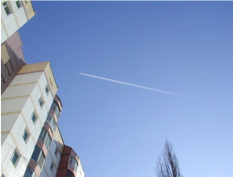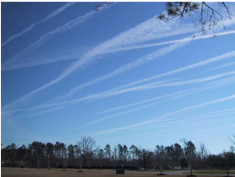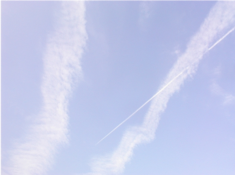The Science of Contrails - Clouds Protocol
The Science of Contrails
What are contrails?
Contrails are clouds formed when water vapor condenses and freezes around small particles (aerosols) that exist in aircraft exhaust. Some of that water vapor comes from the air around the plane, and some is added by the exhaust of the aircraft.
The exhaust of an aircraft contains both gas (vapor) and solid particles. Both of these are important in the formation of contrails. Some elements of the exhaust gasses are not involved in contrail formation but do constitute air pollution. Emissions include carbon dioxide, water vapor, nitrogen oxides, carbon monoxide, hydrocarbons such as methane, sulfates, and soot and metal particles.
Are there different types of contrails?
Contrails are all made of the same materials and are formed in the same way, but they exist for different lengths of time. Because of the differences in contrail "life-spans," contrails can be divided into three groups: short-lived, persistent (non-spreading) and persistent spreading. See the Contrail Formation Guide (PDF) for more information on how contrails form.



Contrail cousins are things that look like contrails but actually arise from a different physical process. For example, under the right conditions vapor trails form from the wingtips of a jet on takeoff or landing. This phenomenon results from a decrease in pressure and temperature in the wingtip vortex. If conditions are right, liquid water drops form inside the vortex and make it visible. These evaporate very quickly after they form.
Can contrails move, or do they stay in the location where they were formed?
Because contrails are formed at high altitudes where the winds are usually very strong, they will move away from the area where they originated. Often, there are old persistent contrails in the sky that formed far away but moved overhead because of the wind.
How are contrails different from other clouds?
Contrails are "human-induced" clouds since they are formed by water vapor condensing and freezing on particles from airplane exhaust. Contrails are always made of ice particles, due to the very cold temperatures at high altitude. Other types of clouds can be formed by water vapor that condenses on particles which are present in the atmosphere due to many sources, such as from volcanoes or dust storms, not specifically from aircraft exhaust. Those clouds are sometimes made of water droplets, and sometimes ice crystals, depending on the temperature where they form.
Contrails only form at very high altitudes (usually above 8 kilometers) where the air is extremely cold (less than -40 degrees Celsius). Other clouds can form at a range of altitudes, from very close to the ground, such as fog, to very high off the ground, such as cirrus clouds.





